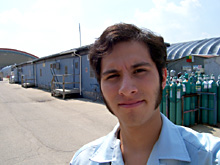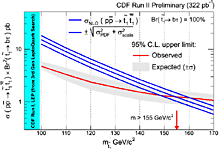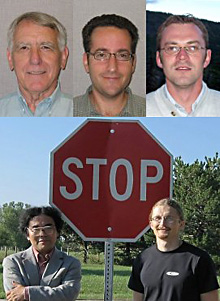 | Thursday, August 25, 2005 |
|
Thursday, August 25 2:30 p.m. Theoretical Physics Seminar - Curia II Speaker: P. Ko, Korea Advanced Institute of Science and Technology Title: Partially Composite Two-Higgs Doublet Model 3:30 p.m. Director's Coffee Break - 2nd Flr X-Over Note: There will be no Accelerator Physics and Technology Seminar today
Friday, August 26 |
|
Extended Forecast |
Secon Level 3 |
|
Thursday, August 25 Minnesota Wild Rice with Chicken Soup Tuna Melt on Nine Grain $4.85 BBQ Ribs $3.75 Chicken Casserole $3.75 Buffalo Chicken Wrap $4.75 Cheesy Breadsticks $3.50 Chicken Pecan Salad $4.85 The Wilson Hall Cafe now accepts Visa, Master Card, Discover and American Express at Cash Register #1. |
|
Thursday, August 25 Dinner Melon and Prosciutto Scallops in Maple Cream Sautéed Pea Pods Black Forest Parfait
Wednesday, August 31
Chez Leon Menu |
| Fermilab Today is online at: http://www.fnal.gov/today/ Send comments and suggestions to today@fnal.gov Fermilab Today archive Fermilab Today PDF Version Fermilab Result of the Week archive Fermilab Safety Tip of the Week archive Linear Collider News archive Fermilab Today classifieds Subscribe/Unsubscribe to |
| Brazil Makes Strides Toward Addressing the Digital Divide A meeting between two physicists at a conference in 2001 has helped lead to a success in addressing the digital divide—the difference in computing and connectivity between the developed and the developing world. "I was concerned about upgrading Brazil's computing capacity for high energy physics," said Alberto Santoro from Rio de Janeiro State University (UERJ). "After reading a paper on grid computing, I approached one of the paper's authors, Harvey Newman from the California Institute of Technology, to talk about Brazil getting involved in grids."
The International Committee on Future Accelerators Standing Committee on Interregional Connectivity, which Newman chairs, had just decided that the digital divide would be a main focus of its activities. The committee started with Latin America, holding its 2002 workshop at UERJ. Representatives from Brazil's National Research and Education Network (RNP), network providers and the local community attended to discuss network requirements for scientific research.
|
|
From Interactions News Wire, August 24, 2005 Bon Voyage - heart of world's biggest physics experiment leaves the UK After years of painstaking effort, the last of the 4 barrels that make up the central part of the Semiconductor Tracker (SCT), the heart of the biggest physics collaboration in the world has today (August 24th) left Oxford for its new home at the European Particle Physics Laboratory, CERN, near Geneva. At CERN, physicists from around the world are assembling the Large Hadron Collider (LHC) which will send two counter-rotating beams of particles round an underground ring at 99.999999 per cent of the speed of light. When the beams are brought into collision, a shower of new particles will be produced reproducing conditions similar to those immediately after the Big Bang. These will be studied at four detectors around the ring. The largest of these detectors is called ATLAS and at its heart lies the SCT tracking the movements of the charged particles produced in the high-energy collision.
|
| Heaviest Top! Lightest Stop? |
||
|
||
|
Supersymmetry (SUSY) is a leading theory that uniquely opens the possibility of directly connecting the Standard Model (SM) of quarks and leptons with an ultimate unification of the fundamental interactions in nature. The theory predicts a SUSY partner for each of the SM particles. Based on the precise measurements we have of the top quark and W boson masses and their interaction strengths, the theory prefers a spectrum of SUSY particles in the range 100 to 1000 times the proton mass.
The top is the heaviest (185 times the proton mass) of the Standard Model's six types of quarks and the last to be discovered, in 1995. However, its SUSY partner (supersymmetric top quark or stop) may be the lighest SUSY particle, so pairs of stops may be copiously produced in collisions at the Fermilab Tevatron and thus the stop may be the first of six supersymmetric quarks to be discovered. A team from CDF tests a particular class of SUSY models where the stop is too light to decay into other SUSY particles, and favorably decays into a tau lepton and a bottom quark instead of an electron or muon or lighter quarks. CDF has developed a special trigger to effectively detect such events. Analyzing 322 pb-1 of data (or about 15 trillion proton-antiproton collisions) collected by the trigger, no signal is observed. The team uses this result to exclude regions of the stop mass below 155 GeV (165 times the proton mass). As Run II continues, more data and improved analysis techniques will help push the sensitivity even higher, and may ultimately reveal evidence for new physics. |
||
|
||
| Result of the Week Archive
|
|
August 22 - August 24 - During this 48 hour period Operations established one store that combined with an existing store provided the experiments with approximately 44 hours and 58 minutes of luminosity - MCenter held off due to LCW trouble
Read the Current Accelerator Update
|
|
International Folk Dancing International Folk Dancing will meet Thursday, Aug. 25, in Wilson Hall's Ramsey Auditorium. Dancing begins at 7:30 p.m. with teaching earlier in the evening and request dancing later on. Newcomers are welcome and you do not need to come with a partner. Dancing will continue in the Auditorium until Sept. 15, when it will return to Kuhn Barn. Info at 630-584-0825 or 630-840-8194 or folkdance@fnal.gov.
Power Outage
Building Manager Notice
Vending Machines Out of Service
|


